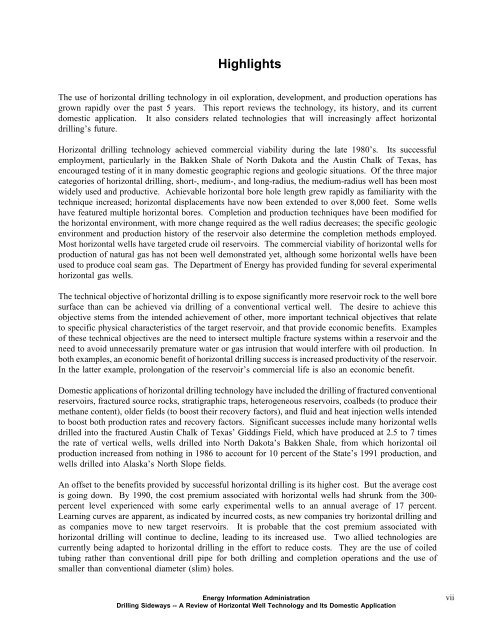Drilling Sideways -- A Review of Horizontal Well Technology ... - EIA
Drilling Sideways -- A Review of Horizontal Well Technology ... - EIA
Drilling Sideways -- A Review of Horizontal Well Technology ... - EIA
You also want an ePaper? Increase the reach of your titles
YUMPU automatically turns print PDFs into web optimized ePapers that Google loves.
Highlights<br />
The use <strong>of</strong> horizontal drilling technology in oil exploration, development, and production operations has<br />
grown rapidly over the past 5 years. This report reviews the technology, its history, and its current<br />
domestic application. It also considers related technologies that will increasingly affect horizontal<br />
drilling’s future.<br />
<strong>Horizontal</strong> drilling technology achieved commercial viability during the late 1980’s. Its successful<br />
employment, particularly in the Bakken Shale <strong>of</strong> North Dakota and the Austin Chalk <strong>of</strong> Texas, has<br />
encouraged testing <strong>of</strong> it in many domestic geographic regions and geologic situations. Of the three major<br />
categories <strong>of</strong> horizontal drilling, short-, medium-, and long-radius, the medium-radius well has been most<br />
widely used and productive. Achievable horizontal bore hole length grew rapidly as familiarity with the<br />
technique increased; horizontal displacements have now been extended to over 8,000 feet. Some wells<br />
have featured multiple horizontal bores. Completion and production techniques have been modified for<br />
the horizontal environment, with more change required as the well radius decreases; the specific geologic<br />
environment and production history <strong>of</strong> the reservoir also determine the completion methods employed.<br />
Most horizontal wells have targeted crude oil reservoirs. The commercial viability <strong>of</strong> horizontal wells for<br />
production <strong>of</strong> natural gas has not been well demonstrated yet, although some horizontal wells have been<br />
used to produce coal seam gas. The Department <strong>of</strong> Energy has provided funding for several experimental<br />
horizontal gas wells.<br />
The technical objective <strong>of</strong> horizontal drilling is to expose significantly more reservoir rock to the well bore<br />
surface than can be achieved via drilling <strong>of</strong> a conventional vertical well. The desire to achieve this<br />
objective stems from the intended achievement <strong>of</strong> other, more important technical objectives that relate<br />
to specific physical characteristics <strong>of</strong> the target reservoir, and that provide economic benefits. Examples<br />
<strong>of</strong> these technical objectives are the need to intersect multiple fracture systems within a reservoir and the<br />
need to avoid unnecessarily premature water or gas intrusion that would interfere with oil production. In<br />
both examples, an economic benefit <strong>of</strong> horizontal drilling success is increased productivity <strong>of</strong> the reservoir.<br />
In the latter example, prolongation <strong>of</strong> the reservoir’s commercial life is also an economic benefit.<br />
Domestic applications <strong>of</strong> horizontal drilling technology have included the drilling <strong>of</strong> fractured conventional<br />
reservoirs, fractured source rocks, stratigraphic traps, heterogeneous reservoirs, coalbeds (to produce their<br />
methane content), older fields (to boost their recovery factors), and fluid and heat injection wells intended<br />
to boost both production rates and recovery factors. Significant successes include many horizontal wells<br />
drilled into the fractured Austin Chalk <strong>of</strong> Texas’ Giddings Field, which have produced at 2.5 to 7 times<br />
the rate <strong>of</strong> vertical wells, wells drilled into North Dakota’s Bakken Shale, from which horizontal oil<br />
production increased from nothing in 1986 to account for 10 percent <strong>of</strong> the State’s 1991 production, and<br />
wells drilled into Alaska’s North Slope fields.<br />
An <strong>of</strong>fset to the benefits provided by successful horizontal drilling is its higher cost. But the average cost<br />
is going down. By 1990, the cost premium associated with horizontal wells had shrunk from the 300percent<br />
level experienced with some early experimental wells to an annual average <strong>of</strong> 17 percent.<br />
Learning curves are apparent, as indicated by incurred costs, as new companies try horizontal drilling and<br />
as companies move to new target reservoirs. It is probable that the cost premium associated with<br />
horizontal drilling will continue to decline, leading to its increased use. Two allied technologies are<br />
currently being adapted to horizontal drilling in the effort to reduce costs. They are the use <strong>of</strong> coiled<br />
tubing rather than conventional drill pipe for both drilling and completion operations and the use <strong>of</strong><br />
smaller than conventional diameter (slim) holes.<br />
Energy Information Administration vii<br />
<strong>Drilling</strong> <strong>Sideways</strong> -- A <strong>Review</strong> <strong>of</strong> <strong>Horizontal</strong> <strong>Well</strong> <strong>Technology</strong> and Its Domestic Application

















